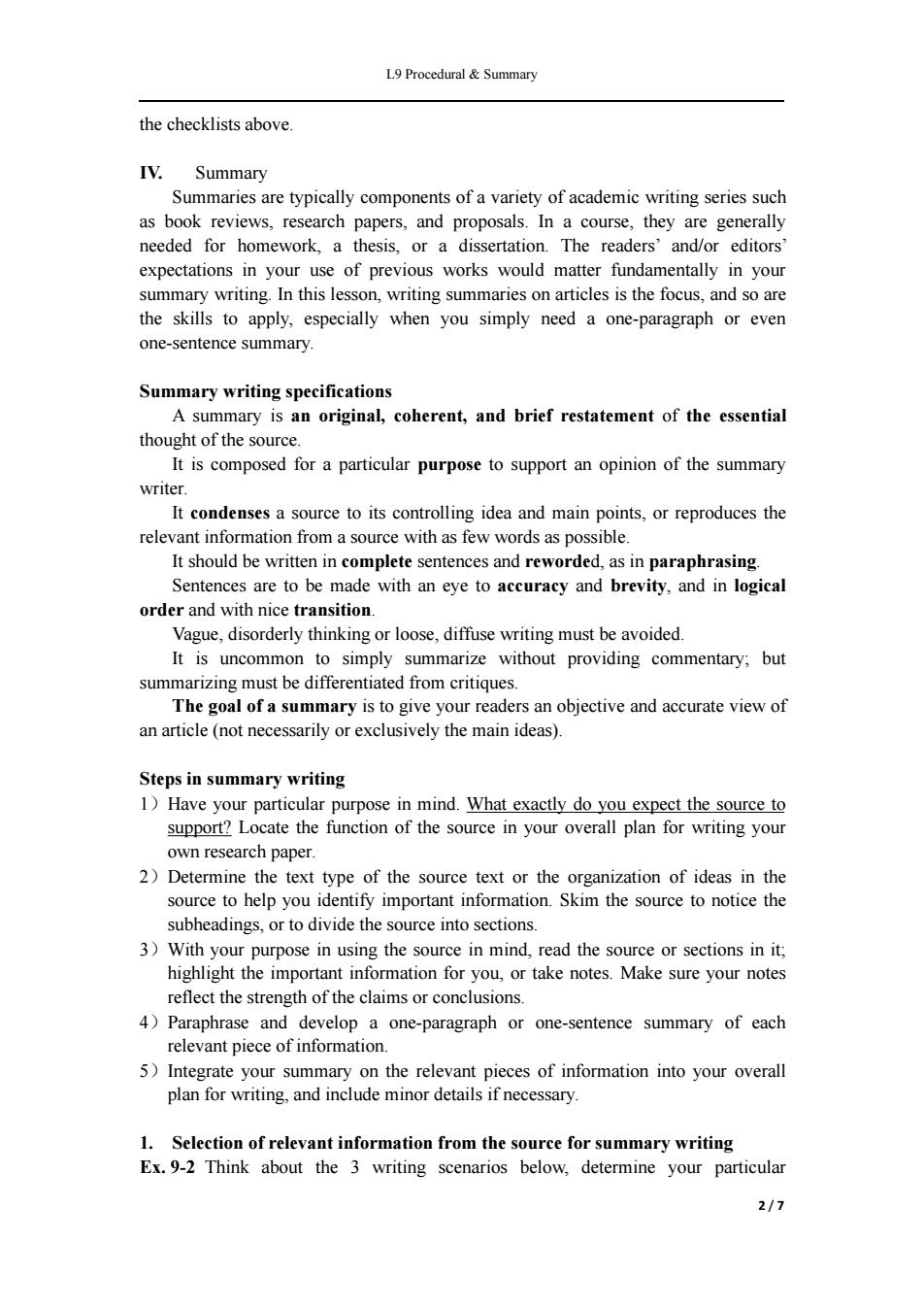正在加载图片...

L9 Procedural Summary the checklists above. IV.Summary Summaries are typically components of a variety of academic writing series such as book reviews,research papers,and proposals.In a course,they are generally needed for homework,a thesis,or a dissertation.The readers'and/or editors expectations in your use of previous works would matter fundamentally in your summary writing.In this lesson,writing summaries on articles is the focus,and so are the skills to apply,especially when you simply need a one-paragraph or even one-sentence summary. Summary writing specifications A summary is an original,coherent,and brief restatement of the essential thought of the source. It is composed for a particular purpose to support an opinion of the summary writer. It condenses a source to its controlling idea and main points,or reproduces the relevant information from a source with as few words as possible. It should be written in complete sentences and reworded,as in paraphrasing. Sentences are to be made with an eye to accuracy and brevity,and in logical order and with nice transition. Vague,disorderly thinking or loose,diffuse writing must be avoided. It is uncommon to simply summarize without providing commentary;but summarizing must be differentiated from critiques. The goal of a summary is to give your readers an objective and accurate view of an article(not necessarily or exclusively the main ideas). Steps in summary writing 1)Have your particular purpose in mind.What exactly do you expect the source to support?Locate the function of the source in your overall plan for writing your own research paper. 2)Determine the text type of the source text or the organization of ideas in the source to help you identify important information.Skim the source to notice the subheadings,or to divide the source into sections. 3)With your purpose in using the source in mind,read the source or sections in it; highlight the important information for you,or take notes.Make sure your notes reflect the strength of the claims or conclusions. 4)Paraphrase and develop a one-paragraph or one-sentence summary of each relevant piece of information. 5)Integrate your summary on the relevant pieces of information into your overall plan for writing,and include minor details if necessary. 1.Selection of relevant information from the source for summary writing Ex.9-2 Think about the 3 writing scenarios below,determine your particular 2/7L9 Procedural & Summary 2 / 7 the checklists above. IV. Summary Summaries are typically components of a variety of academic writing series such as book reviews, research papers, and proposals. In a course, they are generally needed for homework, a thesis, or a dissertation. The readers’ and/or editors’ expectations in your use of previous works would matter fundamentally in your summary writing. In this lesson, writing summaries on articles is the focus, and so are the skills to apply, especially when you simply need a one-paragraph or even one-sentence summary. Summary writing specifications A summary is an original, coherent, and brief restatement of the essential thought of the source. It is composed for a particular purpose to support an opinion of the summary writer. It condenses a source to its controlling idea and main points, or reproduces the relevant information from a source with as few words as possible. It should be written in complete sentences and reworded, as in paraphrasing. Sentences are to be made with an eye to accuracy and brevity, and in logical order and with nice transition. Vague, disorderly thinking or loose, diffuse writing must be avoided. It is uncommon to simply summarize without providing commentary; but summarizing must be differentiated from critiques. The goal of a summary is to give your readers an objective and accurate view of an article (not necessarily or exclusively the main ideas). Steps in summary writing 1)Have your particular purpose in mind. What exactly do you expect the source to support? Locate the function of the source in your overall plan for writing your own research paper. 2)Determine the text type of the source text or the organization of ideas in the source to help you identify important information. Skim the source to notice the subheadings, or to divide the source into sections. 3)With your purpose in using the source in mind, read the source or sections in it; highlight the important information for you, or take notes. Make sure your notes reflect the strength of the claims or conclusions. 4)Paraphrase and develop a one-paragraph or one-sentence summary of each relevant piece of information. 5)Integrate your summary on the relevant pieces of information into your overall plan for writing, and include minor details if necessary. 1. Selection of relevant information from the source for summary writing Ex. 9-2 Think about the 3 writing scenarios below, determine your particular